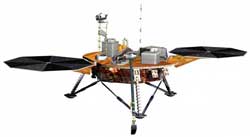
Posted to News on 11th Jul 2007, 08:01
Wind River software to help in search for life on mars
Wind River's VxWorks will be onboard NASA's Phoenix Mars Lander spacecraft to control the various scientific instruments - including a robotic arm.

NASA's Phoenix Mars Lander spacecraft will launch in Florida on 3 August 2007, with the intention of landing on a Martian arctic plain the following spring. A collection of instruments, including a robotic arm and soil-sampling facilities, will be on-board, powered by the Rad6000 onboard computer – running Wind River VxWorks.
The Rad6000 will be running VxWorks for Rad6000, created by Device Software Optimisation (DSO) experts Wind River. Wind River VxWorks platforms are designed for device software developers who build differentiated devices requiring a small footprint, high performance, and real-time, deterministic behaviour.
Like the other Rad6000 systems used on previous Mars exploration projects, there is only one main, general-purpose computer on board the Phoenix. Its jobs include controlling the execution of trajectory correction manoeuvres calculated by navigators during cruise phase, and controlling EDL (Entry, Descent and Landing) manoeuvres.
Phoenix is the first mission of NASA's Mars Scout Program of competitively proposed, relatively low-cost missions to Mars. Selected in 2003, Phoenix saves expense by using a lander structure and other components originally built for a 2001 mission that was cancelled while in development. VxWorks allows standardisation across projects, revisions and organisations – thereby reducing tool investment, capital cost and training time.
Track record
VxWorks provides a highly integrated, feature-rich technology platform with a heritage of successful deployment by JPL in both on-planet and deep-space robotic experiments. This deployment builds on a successful track record of eight successful Mars and deep-space missions with Wind River on board, including the Mars Rover and Stardust missions.
Mike Deliman, Wind River's engineering specialist for the Phoenix project, comments: "If you wanted to look at the craft as a body, and the various science stations as senses, the Rad6000 running VxWorks would be the brain.
"The Wind River team assisted them with their applications as needed, but JPL researchers and other Phoenix team members created nearly all of their applications themselves. We leave those tasks to the experts."
Phoenix will use a robotic digging arm and other instruments to determine whether the soil environment just beneath the surface could have been a favourable habitat for microbial life. Studies from orbit suggest that within an arm's reach of the surface, the soil holds frozen water.
Other Instruments controlled by the Rad6000 onboard computer are as follows.
Robotic Arm (RA)- built by the Jet Propulsion Laboratory
The RA is critical to the operations of the Phoenix lander and is designed to dig trenches, scoop up soil and water ice samples, and deliver these samples to the TEGA and MECA instruments for detailed chemical and geological analysis.
Microscopy, Electrochemistry, and Conductivity Analyser (MECA)- built by the Jet Propulsion Laboratory
MECA is a combination of several scientific instruments including a wet chemistry laboratory, optical and atomic force microscopes, and a thermal and electrical conductivity probe.
Robotic Arm Camera (RAC)- built by the University of Arizona and Max Planck Institute, Germany
The RAC is attached to the Robotic Arm (RA) just above the scoop.
Surface Stereo Imager (SSI)- built by the University of Arizona
SSI will serve as Phoenix's 'eyes' for the mission, providing high-resolution, stereoscopic, panoramic images of the Martian arctic.
Thermal and Evolved Gas Analyser (TEGA)- built by the University of Arizona and University of Texas, Dallas
TEGA is a combination high-temperature furnace and mass spectrometer instrument that scientists will use to analyse Martian ice and soil samples.
Mars Descent Imager (MARDI)- built by Malin Space Science Systems
MARDI plays a key science role during Phoenix's descent to the Martian arctic.
Meteorological Station (MET)- built by the Canadian Space Agency
Throughout the course of the Phoenix surface operations, MET will record the daily weather of the Martian northern plains.















